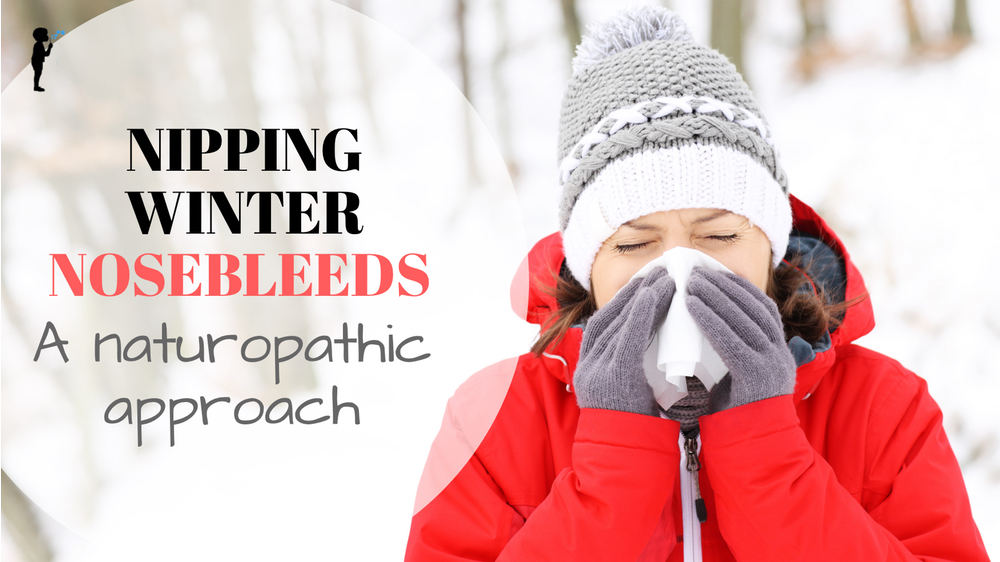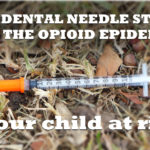
Nipping Winter Nosebleeds – A Naturopathic Approach
It’s not uncommon for children to experience nosebleeds in the winter. The blood vessels that line your child’s nose are extremely delicate. When air temperature and moisture drop in the winter this can dry out the nasal passages. This leads to tiny cracks and crusting, which can cause those little blood vessels to swell and break open1,2. These small blood vessels can also break open due to inflammation from a cold, or even just by blowing a dry nose in the winter.
While minor nosebleeds can be safely treated at home, more serious nosebleeds should be assessed by your naturopathic doctor or family physician.

Preventing Winter Nosebleeds:
- Humidify indoor air. If your home has forced air from a furnace, consider installing a humidifier to your furnace to add moisture to indoor air. For your child’s room, humidity can be increased by using a cool-air humidifier, which are available at most department and hardware stores.
- Hydrate from the inside. Encourage water intake to maintain adequate hydration. Your child will lose a lot of moisture just by simply breathing at night; ensure that it’s replaced by helping your child to stay hydrated. For more information about optimal water intake for kids, and tips to get them drink more water, check out the following article: Can drinking more water make your kid smarter?
- Rinse the nose. Using a natural saline nasal rinse or a xylitol-based nasal rinse can be helpful to rehydrate dry nasal passages. Xylitol is a natural sweetener found in fruits and vegetables, and when used in nasal rinses and sprays, it can help to maintain moisture in the nasal passages. Children I see in my practice tend to prefer xylitol based nasal rinses, as they naturally taste sweet, which kids enjoy. An additional benefit to using xylitol is that research has shown xylitol nasal sprays to be helpful in relieving the symptoms of sinus inflammation3. Further research is exploring whether xylitol candies can be helpful in preventing dental cavities in children4. There are several companies who manufacture xylitol based nasal sprays, which can be found in many pharmacies and health shops. Consults with your child’s naturopathic doctor before using any xylitol products to be sure that it’s the right choice for your child.
- Assess nutritional status. A naturopathic doctor or registered dietitian can assess your child for signs of low vitamin K, which, in some cases, can be associated with more frequent nosebleeds. Vitamin C can also be helpful to prevent fragility of the tiny blood vessels; a naturopathic doctor can help to determine if vitamin C is right for your child.
- Reduce damage from picking. If your child’s nose is dry, it may feel uncomfortable and itchy, leading to picking or scratching. Realistically, young children may pick at their nose when you’re not looking. If your child is at a prime nose-picking age, be sure to keep their nails short and rounded to minimize scratches that can lead to nosebleeds.
- Moisturize. Moisturizing the inner and outer nostrils with natural Shea butter can help to soften tender skin. Shea butter is a nut butter derived from the Shea tree, which grows in Africa; it is moisturizing and softening to the skin, and can help to reduce moisture loss. It makes a nice alternative to petroleum jelly for preventing skin dryness, and can be found in most health shops. Shea is distantly related to the Brazil nut tree, so if your child has tree nut allergies, it’s best to avoid use of Shea butter until research about allergy risk is more conclusive5. Your naturopathic doctor can also recommend other moisturizers that may be helpful for your child.
“Most cases of nosebleeds will resolve within minutes by pinching the bridge of the nose firmly between both fingers for 10 minutes, and tilting the head forward.”
Treating minor nosebleeds at home:
- Reassure your child. Explain to them that it’s because their nose is dry, and that it should stop within a few minutes. For some kids, the sight of blood is very alarming and can induce panic. It’s most important for the parent or caregiver to remain calm and reassuring.
- Pinch and tilt forward. Most cases of nosebleeds will resolve within minutes by pinching the bridge of the nose firmly between both fingers for 10 minutes6,7. Keep your child sitting up, with their head tilted forward. A cold compress may also be applied to the nose, but this is usually not necessary.
When to seek help:
- In some cases, recurring nosebleeds can be a sign of an underlying medical condition10,11. If your child experiences frequent nosebleeds, or if the nosebleeds are severe and you’re unable to stop them at home within a few minutes, have them assessed by a naturopathic doctor or medical doctor.
- In rare cases children will experience nosebleeds with migraine headaches; if this occurs, have your child assessed by their family doctor12.
Seek immediate emergency medical attention if:
- your child is losing a lot of blood, or you can’t control the bleeding within 30 minutes.
- your child put something up their nose. Do NOT try to remove the object yourself – this can cause further damage8,9.
- your child suffered an injury, such as a fall, or being hit in the face with any object.
- your child recently had any ear, nose, adenoid or throat surgery.
References:
-
McDonald, T. (1987). Nosebleed in children. Postgraduate Medicine; 81(1): 217-224. Background and techniques to stop the flow. Published online May 16, 2016.
-
Haddad, J. (2004). Acquired Disorders of the Nose, in Berhman, R, Kliegman, R, Jenson, H. Nelson Textbook of Pediatrics, 17th Saunders; 2004.
-
Lin L, Tang X, Wei J, Dai F, Sun G. (2017). Xylitol nasal irrigation in the treatment of chronic rhinosinusitis. Am J Otolaryngol; 38(4):383-389.
-
Alanen, P, Isokangas, P, Gutmann, K. Xylitol candies in caries prevention: results of a field study in Estonian children. (2000). Community Dentistry and Oral Epidemiology; 28(3): 218-224.
-
Chawla K, Bencharitiwong R, Ayuso, R. Grishina G, Nowak-Wegrzyn A. (2011). Shea butter contains no IgE-inding soluble proteins. J Allergy Clin Immunol; 127(3): 680-682.
-
Burton, M, Doree, C. (2004). Interventions for recurrent idiopathic epistaxis (nosebleeds) in children.
-
The Hospital for Sick Children. (2006). Adapted from Prince V, Campisi, P, Blanchette, V. Guidelines for the Investigation and Management of Epistaxis in Children [internal document]. Toronto, Ontario, Canada; Hospital for Sick Children; 2005, 2006.
-
Tong M, Ying, S, van Hasselt, C. (1996). Nasal foreign bodies in children. International journal of pediatric Otorhinolaryngology; 35(3): 20i7-211. Cochrane Ear, Nose and Throat Disorders Group. The Cochrane Database of Systematic Reviews, 2004.
-
Kiger, J, Brenkert, T, Losek, J. (2008). Nasal foreign body removal in children. Pediatric emergency care; 24(11): 785-792.
-
Doroshenko L, Barkagan L, Sokolova F, Kosikhina T. (1991). Pre-hospital diagnosis of nosebleed in children. Vetnik Otorinolaringologii; 6(38): 38-41.
-
Sandoval, C, Dong, S, Visintainer, P. (2002). Clinical and laboratory features of 178 children with recurrent epistaxis. Journal of pediatric hematology/oncology; 24(1); 47-49.
-
Ahmed, M, Lam, J. (2015). Migraine and nosebleed in children case series and literature review. European Journal of Paediatric Neurology; 19(1): 98-101.


